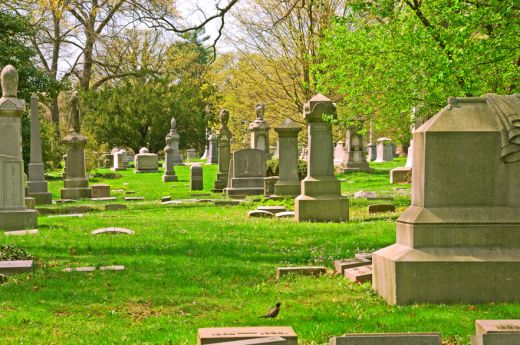Yesterday we looked at how new believers in other cultures could possibly symbolize their death and resurrection in Jesus through using the burial symbolism of their culture.
In western culture, there are two main customs on how to treat people who die: they are buried or cremated.
Burial Symbolism and Water Baptism
Water baptism is a decent picture of burial, but the image might be even better if rather than dress the baptismal candidates in robes of white, they dressed as we would a dead body, and maybe the symbolism could be enhanced if there was a burial procession on the way to the baptism, and if the baptismal tank looked less like a hot tub and more like a casket. These sorts of adjustments to water baptism would make the death, burial, and resurrection symbolism much more clear for the average viewer.

What might be really symbolic is to have an actual casket up on the stage, and have the baptismal candidate lay down in it in front of everyone. The lid is closed, and then after a short period, is reopened, and to everyone’s amazement, the body is gone! But then the person reappears at the back of the room and walks again to the front. This sort of thing is done all the time in magic shows, and while I don’t know how the magicians do it, if a church could pull this off, it would do a wonderful job symbolizing the death, burial, and miraculous resurrection of those who believe in Jesus for eternal life.
The danger with such an idea is that the ceremony becomes more of a magic show than a symbol of a life-changing event. But then, most baptismal ceremonies today are little more than magic rites and shows anyway.
Cremation Symbolism
Safely symbolizing cremation would be much more difficult. But again, maybe someone could make a replica of themselves out of wood or straw, and then dress it in their clothes, and in front of everyone, burn the replica on a funeral pyre. When the fire dies, the ashes could then be collected and scattered in some important location.
These are a few examples of symbolic rituals that could be adopted today in lieu of water baptism which might do a better job of representing our full identification with Jesus Christ in His death, burial, and resurrection, and which, when we undergo them, would cause people who know us and observe what we are doing, to ask us why we would perform such a bizarre and morbid action.
But these are not the only possibilities for representing a break with the past and a change for a new life in the future. Our culture is full of other symbolic gestures for showing such a break. We will look at several of these in the next couple posts.




Of course, the most famous magic-show escape routines also involve being submersed in water. Just sayin’. 😉
True!
I’m not surprised you came up with something like this – although I think having the body disappear looks too gimmicky; it would be enough to remove the lid and the person gets up, like the widow of Nain’s son.
But I see a fallacy in your whole line of argument. If the normal Jewish way of disposing of dead bodies had been in water, then the close link in mode between this and baptism would have been demonstrated. But in fact the Jews buried their bodies, just as we usually do, or have done until quite recently. So if they used water for baptism, there is nothing in the parallel to suggest that we should give it up. Now a casket-shaped baptismal tank that the candidate lies down in – that would make sense.
I agree with you Peter, that water never really ‘looked’ like’ burial, and that wasn’t it’s purpose. It wasn’t that it looked like burial but that the possibility of drowning but also it’s necessity for life that made it a strong symbol for both death and life.
As far as actually including burial into the symbolism, some early Christians would have catechumen wait in a cave or crypt as the final moments of reflection before being baptized, then they would emerge from it in reminiscence of Jesus emerging from His tomb before being baptized. If the ceremony was done at Easter time, the Paschal candle could also be added to the procession (light overcoming darkness and making sure the ‘fire’ aspect was present a la Matthew 3:11).
Peter and John,
Yes, I was afraid of that too. That last thing we need in church is more gimmicks!
Peter, I was thinking about writing some about the early church’s view and practice of cremation. Do you know of any good resources for this?
Sorry, can’t help you on that one.
This blog post was extremely interesting and brought up ideas and thoughts that I can’t admit to ever having. I particularly found your ideas for symbolizing cremation interesting. However, I’m one of those old-school ministers who believe that baptism should be a simple ceremony—nothing with big lights or theatrics. But to each his own!
Margo,
Yes, when I baptize people, the less fanfare the better! Simple is always best. Simple clothes. Simple service. Simple ceremony. Simple location.
A baptism day is very symbolic, and very important! We are planning for my child’s baptism day right now even as we speak, Do you know a good place to get baptism dresses from? I just checked out http://www.dressedinwhite.com/ and they had alot of cute stuff but I want to check out my other options as well.